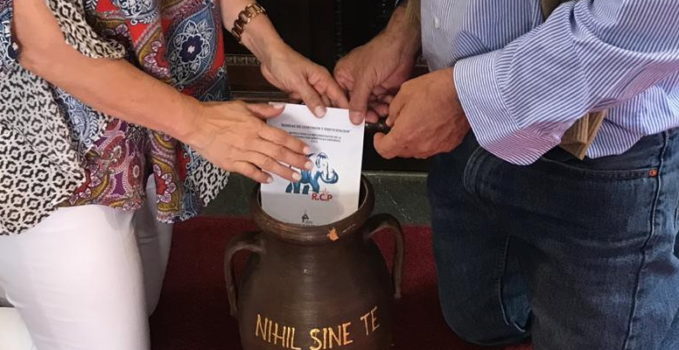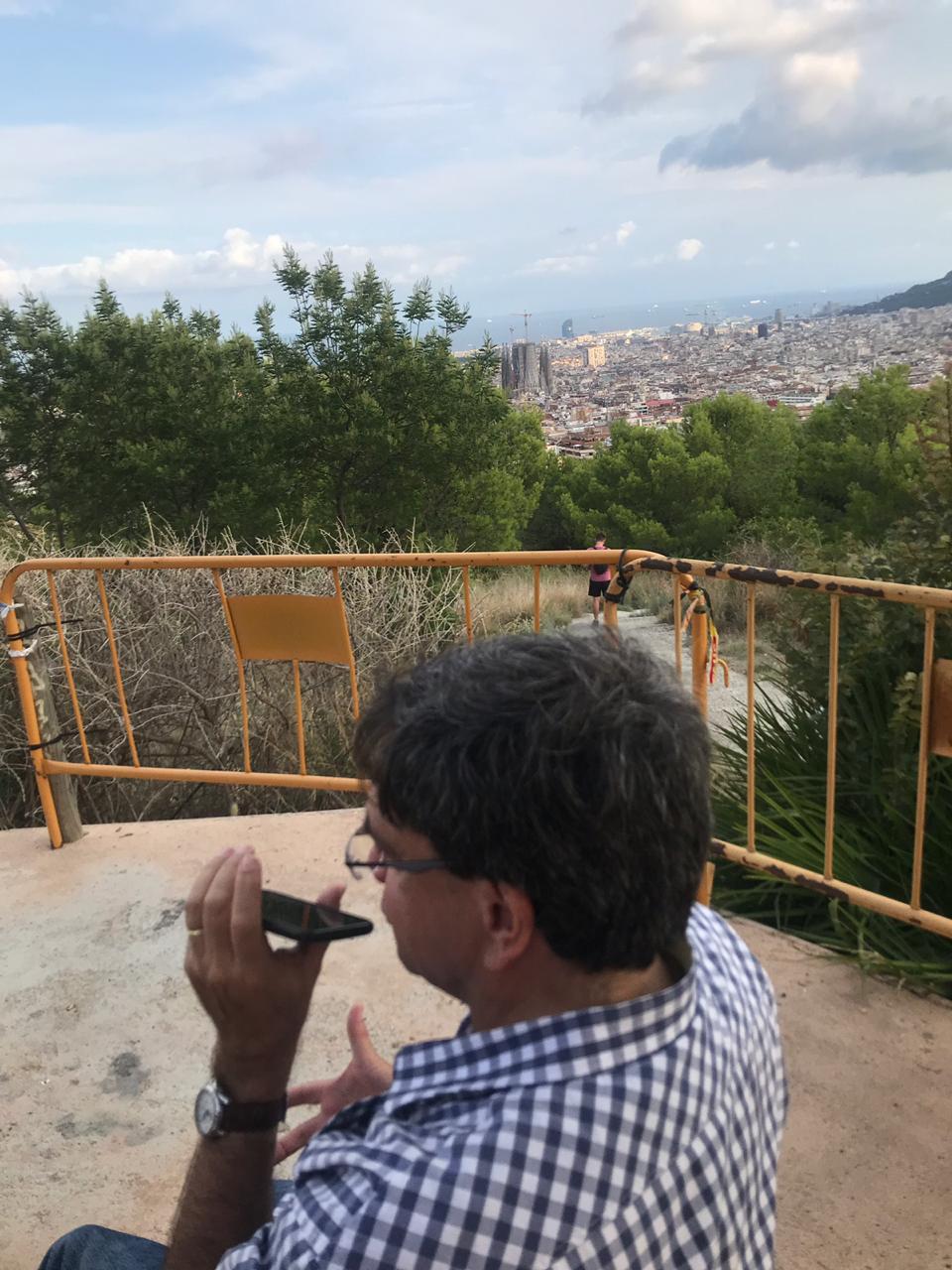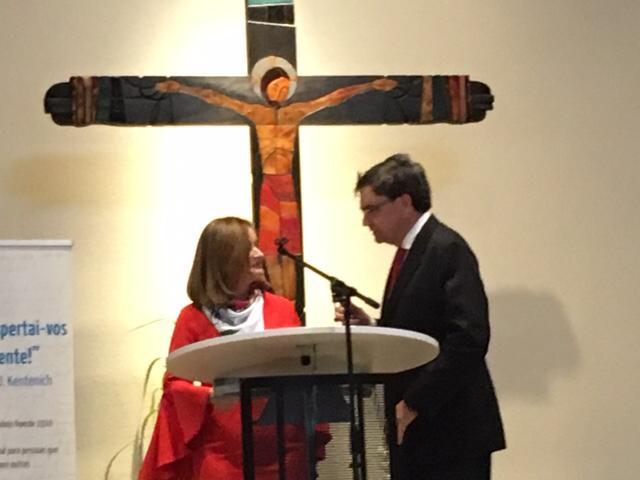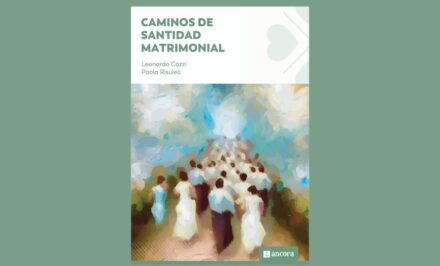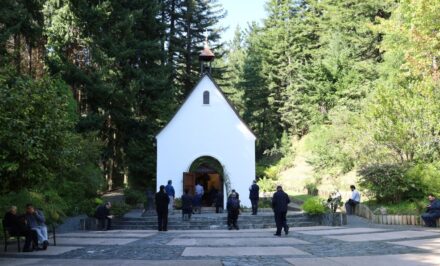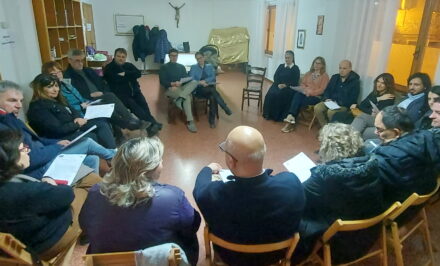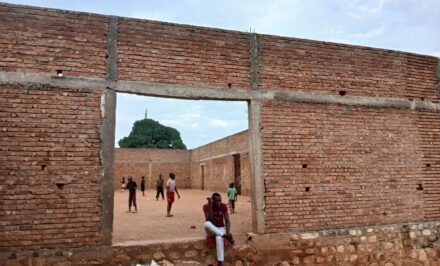COSTA RICA, schoenstatt.org in conversation with “los tempranitos or early birds of the Universal Apostolic Confederation,” Elizabeth Fields and Alejandro Robles •
“Everyone said this was impossible. Then one came that didn’t know, and just did.” As we talked via WhatsApp between Barcelona and Cologne until we ran out of cellphone batteries, my gaze stumbled upon a postcard that had been “residing” on my desk for years that said: “Everyone said this was impossible. Then one came that didn’t know, and just did.” In this case, a married couple came, Elizabeth Field and Alejandro Robles, from Costa Rica. They fell in love with Father Kentenich’s mammoth idea– taken from Saint Vincent Pallotti, and communicated for the first time as a goal in a letter dated 22 May 1916–of coordinating apostolic forces in and for the service of the Church. As a result, they simply made it a reality in Costa Rica’s Archdiocese of San José. —
In short in the Archdiocese of San Jose, this Family Federation couple presented a plan to bring parishes together with existing Apostolic Movements in the Archdiocese, so they can work together with existing Movements – a plan that has been accepted, a bold plan, and at the same time so simple and logical.
“The Universal Apostolic Confederation, has thus been a task relegated to oblivion, practically reduced to some philosophical concept we all repeat and have in mind, but no one faithfully tries to put into practice,” said Manuel Emilio Montero in a contribution for Schoenstatt Vivo. “In Costa Rica, a couple from the Family Federation has presented a plan to the Archdiocese of San José to bring the parishes closer to Apostolic Movements existing in the Archdiocese, so the parishes can work in common with the Movements. It is a first effort to unite Movements and parishes from an official perspective.”
“Everyone said this was impossible. Then one came that didn’t know, and just did.”
“The idea of the Universal Apostolic Confederation captivated us, inspired us, brought us sleepless nights, and became a challenge to be met.”
How did this idea of simply implementing the Universal Apostolic Confederation come about? In the same way every Schoenstatt project has arisen and how the Schoenstatt Movement has emerged –in a sincere dialogue between the voices of the times and personal vocations of those involved–organically.
“In 2016, we entered the Schoenstatt Family Federation,” Alejandro said. “After discerning for a long time if this really was our vocation as a couple, we were not satisfied with what we first knew about this community of hearts only. When we learned that it was not just that, but that it was about training ourselves in freedom and originality for the apostolate, we had a better understanding of what it was.
One of the first assigned readings at Federation meetings was the book, Hörde 1919: Greatness and Limits of a Journey (available in Spanish and German). This book decisively marked us as a couple, the more we felt as children of our Father and Founder, and especially when we assumed that “everything depends on us.” In addition, we understood that things happen– if and only if– we take action on them, and with the help of the Holy Spirit, we will be able to undertake our goal. We were clear about the end, but not the how. From the beginning, the idea of the Universal Apostolic Confederation captivated us, inspired us, caused us some sleepless nights, and became a challenge to be fulfilled. We didn’t know how to do it, but the illusion of making it a reality was our passion. In our hearts, we assumed the dream of making the third milestone of Schoenstatt a reality,” said Elizabeth.
While she is speaking, I remember how we spoke about the theme on the night of 19 January 2019, at the Family of Hope Shrine in Costa Rica– with very little time and great enthusiasm, the two presented the plan of the “Rounds of Communion and Participation,” to me, and they told me how they worked with the Movements and parish priests, and how everything seemed crazy, but it seemed to work… and how it awakened joy, strengthened identity, and the desire to go out in Movements like parishes.
“Our marriage ideal motivates us to present Jesus and Mary to the world,” said Alejandro. Everything is clear. They had to. Simply.
“We always did things, always something different from other people’s projects,” Elizabeth explained, “like the ‘early birds.” True the early birds.
The “early birds” are now the “UNIVERSAL APOSTOLIC CONFEDERATION’s early birds!”
“We always did things, always something different from other people’s projects,” Elizabeth explained, “like the ‘early birds.” True, the early birds.
“The ‘early birds’ are a group founded on 17 October 2007 and integrated by members of the different Schoenstatt Family Branches that live east of San José, Costa Rica’s capital. Once a month, they meet at 5:00 a.m. to pray the rosary at the MTA wayside shrine on one of the hills east of the city. The desire: that the Blessed Mother be installed in a daughter shrine in Costa Rica. Perseverance, self-giving, and Alejandro and Elizabeth Robles’ loyalty drew them. They devoutly prayed the holy rosary with meditations, songs, and then shared their friendship and affection… as well as delighting in the delicious sandwiches offered by the attendees. “On 17 October 2013, at 5:30 a.m., many Schoenstatters can say that we completed six years of leaving the comfort and warmth of our beds to go out to conquer the offering to our beloved Blessed Mother: almost a God inspired ‘madness’ led us to the mission of founding ‘early birds.’
This can be found in an article from 2013 on schoenstatt.org.
The desire was fulfilled on March 18, 2017 with the blessing of the Family of Hope Shrine.
And the “early birds” of the greatly longed shrine for are now the “Universal Apostolic Confederation’s early birds”.
A task turned into an open door
Elizabeth and Alejandro relate: “Being catechists in 2015, we had the opportunity, as a married couple, to be advisors to the Archdiocese of San José in the implementation of the Archdiocesan Pastoral Plan. As a result, we attended several meetings of the clergy along with the Archbishop. During this experience, the desire to offer Schoenstatt’s pedagogy to the Church was sown in our hearts. One of our first attempts to give Fr. Kentenich’s pedagogy was in giving a small course on the Personal Ideal to the military ministry at a CELAM international seminar.
In February 2017, we were named Schoenstatt representatives before the department of the archdiocese that collects ecclesial Movements, the D-R.E.A.L. The priest, who already knew us from our advice in the archdiocese, showed interest in having us integrate the commission, so we would lead the program of aligning the Movements to the Pastoral Plan, a program that after almost ten years had existed without achieving any concrete results.
What now?
A professional practice turned into a “wide open door.”
The answer came from a professional practice they both knew how to apply: “As entrepreneurs, we had attended the BTM business rounds before (Buyers’ Trade Mission), organized by the Foreign Trade Promotion Agency of Costa Rica (PROCOMER) for producing companies in Costa Rica and buyers from all over the world. Producers and traders looking for new horizons for their companies attended these meetings. For PROCOMER, BTM rounds are the strategic element and axis to facilitate and encourage exports from the country.
The BTM international business model consists of a set meeting between national producer entrepreneurs and international buyers in order to establish permanent and solid links between them. Due to the event’s large scale, the BTM is held at the Costa Rican Convention Center. Prior to the meeting, and to ensure the effectiveness of this, an agenda is coordinated for each participant, which defines the meetings each will hold.
Convinced of the appointment before the D-REAL was due to a gift from Divine Providence, one night we found not only a door, but an “open door” in the idea of the rounds, and we asked ourselves: Could it be that the BTM model of PROCOMER could be taken to the Church? Would it be possible to adapt it, and would it serve as a platform to achieve the Third Milestone of Schoenstatt? Is this what Father Kentenich wanted and was looking for? Would it be something like Bartolo Longo with Pompeii and Father Kentenich with Schoenstatt? What would have to change? Would it be madness to present it to the Church? How would the vicars and the Archbishop take it?
That night, inspired by the Holy Spirit, we analyzed and defined all the “macro” details of what the project could be. We felt that approval by the Church was vital to the success of the project, and we came to the conclusion that the model had to be simple, punctual, and very practical. The task was not simple, and in achieving it, it would be necessary to change BTM’s nomenclature and technical terms from business language to an ecclesial language, without losing essential spirit of the networking and matchmaking between the two parties.
Shortly thereafter, we decided to consult with our spiritual advisor, Sister Maria Auxiliadora Bohórquez, who from the start enthusiastically grasped the idea and was an unconditional source of support and ideas for our spiritual madness.
Then we began to knock on doors and to present the model to the corresponding groups. Thus we obtained the approval of all the vicars in charge. First we sought the approval of the D-R.E.A.L. vicar, Father Oscar Céspedes, who was delighted with the model. Among the three of us we baptized the project: Communication and Participation Rounds or RCP, inspired in the Puebla document.
In brackets: RCP is also a medical acronym for “Cardiopulmonary Resuscitation.” At that moment, we thought: will it be a God-coincidence that in using this model we can resuscitate or reanimate the idea of the Universal Apostolic Confederation “mammoth” Saint Vincent Pallotti and Father Kentenich had conceived? Will we be able to make the mammoth walk?
Then we sought the Vicar General’s approval in charge of the Pastoral Plan, with whom we had already worked, and finally the Archbishop’s approval was given. Once the approval of all the corresponding parties were obtained, several presentations of the model were given in D-R.E.A.L department plenary sessions, where there was a very enthusiastic welcome towards the model. Finally we presented the project to parish priests that were also very willing and moved by what was proposed in the model.
First steps and project design
All really great things are simple. So simple that one thinks “of course, that’s the way it should be”. It’s so easy. When no one realizes the immense work needed to achieve this simplicity, then project is perfect, as was the case with RCP.
The project proposed the creation of RCP as meetings between Apostolic Movements and parishes (pastors) in order to unify efforts in evangelization.
In the case of the RCP model that we were proposing, it was necessary that the Apostolic Movements work to identify what they had to offer to the Church, and on their part, parishes worked to identify their needs in the light of the Pastoral Plan defined by each diocese or by each parish. As a result, during meetings, parishes and Movements would be clear about what they need, or could concretely offer, achieving the effectiveness and enthusiasm necessary for the meeting to be a success.
“Many Movements do not have clarity in their charism, in their identity,” said Alejandro and Elizabeth. “The learning process with the Movements was impressive. Now both the Movements and the parish priests pressured us to begin. One of the parish priests summed it up, with a touch of astonishment: “Great. The Movements empower the laity and the Church uses them.” Instruments, we say in Schoenstatt. It is Dilexit Ecclesiam.
The objective is clear:
- To encourage parish priests to work for an ideal: to be a covering for all communities in order to unite the whole apostolic force for evangelization.
- To achieve the incorporation of the Apostolic Movements in parishes, making them protagonists in the process of evangelization.
- To motivate and train parish priests, so they are leaders (with characteristics of an elite group) capable of convoking, perceiving, and promoting the gifts and charisms of the people around them. (That is to say, with free, firm and priestly personalities; based on values of paternity and aspiration to sanctity, according to the pedagogy of Father Kentenich).
- To motivate parishes to realize their role of coordination and welcome with Apostolic Movements, strengthening the evangelizing force of the diocese’s Pastoral Plan and incorporating Apostolic Movements in the work of the parish’s Pastoral Plan.
Presentation at the Hoerde Journey
And beyond …
Although this is a project of the Archdiocese of San José, its design is applicable to the entire world’s dioceses.
“We want to establish a meeting place between Movements and parishes in order to maximize Catholic evangelization at the international level. This will allow uniting and coordinating existing apostolic forces in communities, maintaining and valuing their respective autonomies, objectives, and charisms as Father Joseph Kentenich thought,” they commented.
The RCP model is designed to be replicated and adapted to any diocese in the world that wants to implement it. The model seeks to be a sign and model of cooperation between communities to foster unity among the different communities of the Church.
On January 20, Elizabeth and Alejandro presented the project to Fr Heinrich Walter of the World Coordination. “He wanted to invite us to the Pentecost Journey to present it, but Elizabeth said: No, this is Hoerde!” Only on May 31st, after several late emails and other obstacles, did he confirm an invitation to present the project at the Hoerde Journey.
“Scared with our own courage, we reasoned: “We don’t have money, we don’t have time,” but our children insisted– and so we went.”
For many, the presentation of “Communication and Participation Rounds” was the Hoerde International Journey’s highlight. People from Germany, Austria, Chile, Argentina and Kenya came up to ask for more details.
“The mammoth walks,” says Alejandro.
“Sharing the experience of it helps us to do more crazy things,” Elizabeth commented. “Sharing the charism makes you fall in love again with the charism. We want to offer the covenant to Movements, not to make them Schoenstatt, but as a source of life, grace, and so that it may be a support of unity and mission between Movements and pastors.
A letter written to Pope Francis about the project arrived on 15 September 2019.
Before leaving Schoenstatt in August, the two gave the project to the Blessed Mother’s Capital of Grace in the Original Shrine.
On September 14th, on the eve of the anniversary of Father Kentenich’s death, the first round’s date was confirmed: February 22nd, 2020.
The mammoth walks.
“Everyone said this was impossible. Then one came that didn’t know, and just did.”
RCP Final version brochure 08 2019 – spanish
Original: Spanish. 15. September 2019. Translation: Melissa Peña-Janknegt, USA.


